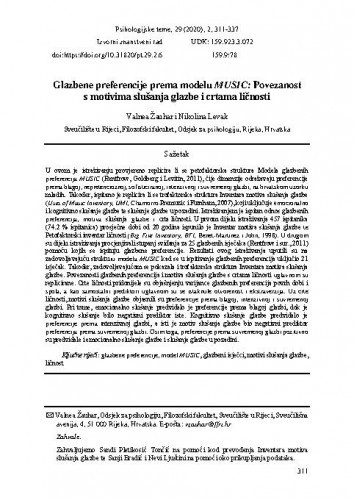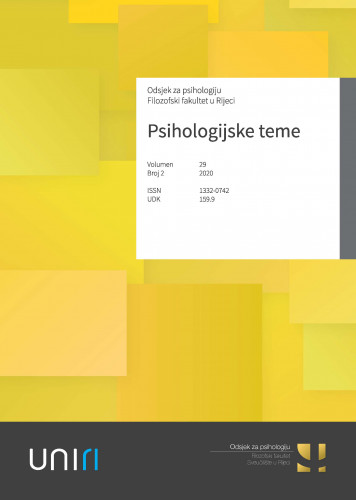U ovom je istraživanju provjereno replicira li se petofaktorska struktura Modela glazbenih preferencija MUSIC (Rentfrow, Goldberg i Levitin, 2011), čije dimenzije odražavaju preferencije prema blagoj, nepretencioznoj, sofisticiranoj, intenzivnoj i suvremenoj glazbi, na hrvatskom uzorku mladih. Također, ispitano je replicira li se trofaktorska struktura Inventara motiva slušanja glazbe (Uses of Music Inventory, UMI, Chamorro-Premuzic i Furnham, 2007), koji uključuje emocionalno i kognitivno slušanje glazbe te slušanje glazbe u pozadini. Istraživanjem je ispitan odnos glazbenih preferencija, motiva slušanja glazbe i crta ličnosti. U prvom dijelu istraživanja 457 ispitanika (74.2 % ispitanica) prosječne dobi od 20 godina ispunilo je Inventar motiva slušanja glazbe te Petofaktorski inventar ličnosti (Big Five Inventory, BFI, Benet-Martinez i John, 1998). U drugom su dijelu istraživanja procjenjivali stupanj sviđanja za 25 glazbenih isječaka (Rentfrow i sur., 2011) pomoću kojih se ispituju glazbene preferencije. Rezultati ovog istraživanja uputili su na zadovoljavajuću strukturu modela MUSIC kad se u ispitivanje glazbenih preferencija uključio 21 isječak. Također, zadovoljavajućom se pokazala i trofaktorska struktura Inventara motiva slušanja glazbe. Povezanosti glazbenih preferencija i motiva slušanja glazbe s crtama ličnosti uglavnom su replicirane. Crte ličnosti pridonijele su objašnjenju varijance glazbenih preferencija povrh dobi i spola, a kao samostalni prediktori uglavnom su se istaknule otvorenost i ekstraverzija. Uz crte ličnosti, motivi slušanja glazbe objasnili su preferencije prema blagoj, intenzivnoj i suvremenoj glazbi. Pri tome, emocionalno slušanje predviđalo je preferencije prema blagoj glazbi, dok je kognitivno slušanje bilo negativni prediktor iste.; This study aimed to examine whether the five-factor structure of the MUSIC model (Rentfrow, Goldberg, & Levitin, 2011) including dimensions that reflect preferences for Mellow, Unpretentious, Sophisticated, Intense and Contemporary music replicates in a Croatian sample. Furthermore, the study aimed to examine the replicability of the three-factor structure of the Uses of Music Inventory (UMI, Chamorro-Premuzic & Furnham, 2007) including emotional, cognitive and background uses of music. Relationships between music preferences, uses of music and personality traits were investigated. In the first part of the study, in a sample of 457 participants (74.2 % female, Mage = 20.27 years) we administered the Uses of Music Inventory and the Big Five Inventory (BFI, Benet-Martinez & John, 1998). In the second part of the study, participants judged their liking of 25 excerpts of music (Rentfrow et al., 2011). The results showed the replicability of the five-factor MUSIC model when 21 excerpts of music are included in the analysis. The results showed the replicability of the three-factor structure of the Uses of music inventory, too. Relationships between music preferences, as well as between uses of music and personality traits were mainly confirmed. Personality traits explained music preference variances above age and gender, with openness to experience and extraversion being significant predictors. Uses of music additionally explained preferences for Mellow, Intense and Contemporary music only. Higher levels of emotional use of music and lower levels of cognitive use of music predicted increased preferences for Mellow music. Higher levels of cognitive use of music predicted increased preferences for Intense music. Lower levels of cognitive use of music and higher levels of emotional and background uses of music predicted preferences for Contemporary music.
Sažetak

 Psihologijske teme : 29,2(2020) / glavna i odgovorna urednica Barbara Kalebić Maglica.
Psihologijske teme : 29,2(2020) / glavna i odgovorna urednica Barbara Kalebić Maglica.